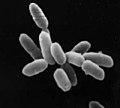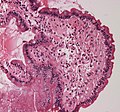Gas vesicles, also known as gas vacuoles, are nanocompartments in certain prokaryotic organisms, which help in buoyancy. Gas vesicles are composed entirely...
22 KB (2,713 words) - 07:53, 6 May 2024
cell biology, a vesicle is a structure within or outside a cell, consisting of liquid or cytoplasm enclosed by a lipid bilayer. Vesicles form naturally...
36 KB (3,649 words) - 05:36, 29 June 2024
Bacterial cell structure (section Gas vacuoles)
diameter of the gas vesicle and pressure at which it will collapse – the wider the gas vesicle the weaker it becomes. However, wider gas vesicles are more efficient...
36 KB (4,605 words) - 03:18, 12 May 2024
Haloferax mediterranei (section Gas Vesicles)
mediterranei into a gas-vesicle deficient archaeon H. volcanii, researchers found that H. volcanii is able to produce functional gas vacuoles. Page Species:...
19 KB (1,321 words) - 17:18, 3 December 2023
gas vesicle structural protein found in different phyla of bacteria and archaea for example in Halobacterium salinarum or Haloferax mediterranei. Gas...
4 KB (425 words) - 01:39, 29 November 2023
Marine prokaryotes (section Gas vacuoles)
diameter of the gas vesicle and pressure at which it will collapse—the wider the gas vesicle the weaker it becomes. However, wider gas vesicles are more efficient...
136 KB (12,705 words) - 16:07, 22 October 2024
Vesicular texture (redirect from Vesicle (geology))
filled with gas called vesicles. A related texture is amygdaloidal in which the volcanic rock, usually basalt or andesite, has cavities, or vesicles, that are...
2 KB (234 words) - 13:20, 20 October 2023
doi:10.1111/j.1469-8137.2004.01022.x. Kinsman, R. (January 1991). "Gas vesicle collapse by turgor pressure and its role in buoyancy regulation by Anabaena...
30 KB (3,569 words) - 15:38, 1 November 2024
Volcanic gases are gases given off by active (or, at times, by dormant) volcanoes. These include gases trapped in cavities (vesicles) in volcanic rocks...
23 KB (2,774 words) - 10:20, 5 November 2024
Grenville (25 April 1997). "Vesicle-Specific Noble Gas Analyses of "Popping Rock": Implications for Primordial Noble Gases in Earth". Science. 276 (5312):...
97 KB (9,960 words) - 20:08, 1 November 2024
was a researcher in the fields of Algae, Cyanobacteria, lake ecology, gas vesicles and genetics, covering the European lakes and Baltic Sea. He is noted...
7 KB (868 words) - 10:44, 5 October 2024
In water columns, some cyanobacteria float by forming gas vesicles, as in archaea. These vesicles are not organelles as such. They are not bounded by lipid...
180 KB (17,735 words) - 20:18, 6 October 2024
DasSarma's laboratory has been instrumental in the study of buoyant gas vesicle nanoparticles (GVNPs) in Halobacterium sp. NRC-1, and developed an expression...
14 KB (1,433 words) - 12:24, 30 September 2024
salinarum produce gas vesicles, which allow them to float to the surface where oxygen levels are higher and more light is available. These vesicles are complex...
25 KB (2,487 words) - 18:09, 3 August 2024
Many Halobacterium species possess proteinaceous organelles called gas vesicles. Halobacteria can be found in highly saline lakes such as the Great Salt...
27 KB (2,462 words) - 20:04, 17 October 2024
A striking morphological feature of the organism is the presence of gas vesicles (provide cells the ability to flow in fluid enabling the CDA spores with...
8 KB (886 words) - 07:29, 19 October 2024
Yolk sac (redirect from Umbilical vesicle)
the bilaminar embryonic disc. This is alternatively called the umbilical vesicle by the Terminologia Embryologica (TE), though yolk sac is far more widely...
8 KB (972 words) - 21:55, 3 May 2024
A liposome is a small artificial vesicle, spherical in shape, having at least one lipid bilayer. Due to their hydrophobicity and/or hydrophilicity, biocompatibility...
40 KB (4,365 words) - 15:53, 28 August 2024
Amygdules or amygdales (/əˈmɪɡdjuːlz, -deɪlz/) form when the vesicles (pores from gas bubbles in lava) of a volcanic rock or other extrusive igneous rock...
2 KB (157 words) - 14:05, 27 July 2023
Generally, Chlorobium are rod or vibroid shaped and some species contain gas vesicles. They can develop as single or aggregate cells. They can be green or...
32 KB (3,209 words) - 00:33, 28 October 2024
in bacteria and archaea include encapsulin nanocompartments and big gas vesicles. The first BMCs were observed in the 1950s in electron micrographs of...
75 KB (8,059 words) - 13:32, 6 November 2024
iron, silica, and other dissolved minerals passed through the trapped gas vesicles. These quartz-rich groundwater solutions deposited concentric bands of...
7 KB (945 words) - 05:12, 31 August 2024
bacteria may express curli fibrils. GvpA, forming the walls of particular Gas vesicles, i.e. the buoyancy organelles of aquatic archaea and eubacteria Fap fibrils...
60 KB (6,536 words) - 06:58, 4 November 2024
vesicular volcanic rock that differs from pumice in having larger vesicles, thicker vesicle walls, and being dark colored and denser. Pumice is created when...
29 KB (3,471 words) - 10:44, 19 August 2024
of a Haloquadratum walsbyi square cell. The numerous light dots are gas vesicles that allow flotation to the surface, most likely to acquire oxygen. Scale...
22 KB (2,535 words) - 12:05, 12 June 2024
Nerve agent (redirect from Nerve gas)
Nerve agents, sometimes also called nerve gases, are a class of organic chemicals that disrupt the mechanisms by which nerves transfer messages to organs...
56 KB (6,500 words) - 08:10, 8 September 2024
Polaromonas vacuolata is a psychrophilic bacterium with gas vesicles from the genus Polaromonas, which was isolated from Antarctica. The optimum temperature...
4 KB (340 words) - 09:09, 11 December 2023
flagellum but has potential for movement through the creation of gas vesicles. These gas vesicles have only been produced in the presence of hydrogen and carbon...
9 KB (1,001 words) - 23:32, 22 September 2024
relatively low density, as it is riddled with macroscopic ellipsoidal vesicles (gas bubbles), but in contrast to pumice, scoria always has a specific gravity...
7 KB (991 words) - 17:48, 6 September 2024
roseum sp. nov., a non-motile phototrophic gammaproteobacterium with gas vesicles, and emended description of the genus Halochromatium". International...
2 KB (145 words) - 08:06, 2 November 2024






















